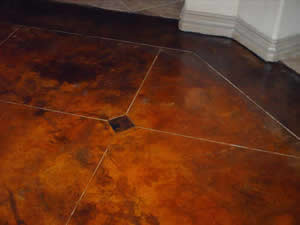
Figure 1 - Acid stained concrete floor
It may be noted that concrete staining is generally not considered a diy home handyman project as it takes some training to stain concrete properly.
Concrete staining can be utilized indoors as well as outdoors. However, in areas subject to icing, the use of salt as an ice remover can cause damage to the concrete surface and the staining.
Concrete staining provides a luxurious appearance, quite different than painting. If one considers the aesthetic differences between staining and painting wood the relationship is the same for concrete.
There are many advantages to staining concrete rather than applying a finishing material on top of the concrete:
Durable:
Concrete that has been stained will last the lifetime of the home, providing it has been properly maintained and that the original concrete floor was installed properly. It should also be noted that stained concrete is not generally damaged by flooding, which makes it an excellent choice for basements.
Properly maintained, stained and sealed concrete will not absorb any additional materials and stain.
Hypoallergenic:
Concrete that is stained and sealed does not provide anywhere for dust to hide nor does it provide a breading ground for mold and mildew.
Note: Some of the products used to stain and seal the concrete may contain VOC's. Hence care must be taken if family members suffer from any respiratory ailments when the installation is being done and when using the sealing products. The VOC's do dissipate after they are used.
Cleaning:
A vacuum, or a broom will pick-up any dust and loose dirt. To remove grime, it is only necessary to use a damp mop with a home floor cleaner.
Maintenance:
In average residential installations a stained concrete floor should be resealed every two years. Resealing the concrete is a relatively simple project and can be accomplished by most homeowners.
As with most things, nothing is ever perfect and there are some disadvantages to a stained concrete floor.
Longevity:
Because concrete staining has an exceptional long life, homeowners can easily tire of its appearance. Re-staining concrete is a very expensive proposition.
In the same manner, changing the decor of a room with a stained concrete floor can be aesthetically difficult. The colors and patterns used when staining the floor cannot be changed or moved (economically). A stained concrete floor can be a negative when reselling, if the potential buyer does not have a desire to opt for a similar decor or color scheme.
It should be noted that the stain used on the concrete does not prevent the homeowner from covering the concrete with a traditional floor covering such as carpet, vinyl sheet or laminates.
Retrofitting:
In most cases adding a stained concrete floor in an area that does not currently have a concrete floor is not an option. Structural considerations to hold the weight of the concrete, plus floor levels make retrofitting a nonstarter in most cases.
Installation:
Although many manufacturers of concrete stains suggest that it is a home handyman project, in my opinion it requires a high degree of artistry rather than home improvement expertise. I therefore recommend using a contractor for concrete staining.
Aesthetic Warmth:
Many individuals do not beleive that concrete has a warmth in its aestetics and in many cases believe that concrete in any manner is cold and uninviting.
